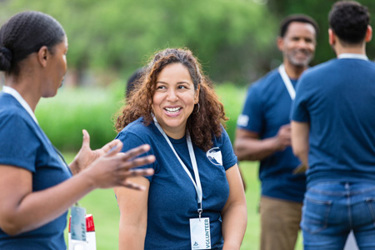Improving Recruitment Needs More Than Transactional Fixes To Earn Patient Trust
By Marlyn Panchoo Brookins, Ph.D., founder, Insightful Intellect

For decades, minority communities have been severely underrepresented in clinical trials. Despite increased investment in DEI, flashy outreach campaigns, and incentives like free transportation and childcare, recruitment gaps persist. Why? Because we’re trying to solve the wrong problem.
The Real Issue Is Trust
As an industry, we often assume that if we reduce logistical barriers, participants will come. And some do. But this logic misses a deeper truth: Many communities don’t trust the research system enough to say yes to participating in a clinical trial — no matter how convenient we make it.
Consider this: Black people make up 13%–14% of the U.S. population but only 5%–7% of clinical trial participants1. Even with well-funded diversity initiatives, NIH programs like those aimed at expanding cancer trial inclusion have failed to shift these numbers2. It’s not a lack of resources — it’s a mismatch in approach.
Mistrust among African Americans isn’t just historical — it’s continuously reinforced by lived experience. The legacy of the Tuskegee syphilis study is a generational touchpoint, representing betrayal and exploitation. In study after study, Black participants describe the word “research” as evoking images of being used as “guinea pigs,” a reflection of both past exploitation and ongoing marginalization4
That exclusion today isn’t always overt — it’s often embedded in seemingly small oversights: study protocols that ignore cultural norms, outreach materials that don’t reflect the communities they target, or staff who lack the cultural competence to engage meaningfully. These moments send a clear message: This research wasn’t built with us in mind. Did you know that ethnic minority patients routinely receive less information, less empathy, and less engagement from providers, reinforcing a cycle of disengagement and mistrust?6
This disconnect spans socioeconomic lines. In one focus group, a Black professional recounted withdrawing from a clinical trial after realizing the research team had no understanding of clippers, a common grooming tool in his community, despite the study focusing on razor burn. Their lack of cultural awareness convinced him the team was unprepared to engage Black participants meaningfully and so he opted out. 4
These aren’t just emotional reactions — they’re informed, rational responses to a system that has repeatedly failed to show transparency, respect, or inclusion. As one participant put it, “You don’t know what they’re giving you… they’re very secretive.” 4
Transactional Fixes Don’t Heal Historical Harm
You can’t rebuild fractured trust with transactional offers. These approaches often engage communities through surface-level interactions. These include short-term incentives like financial compensation, transportation, childcare, or giveaways — all designed to get quick enrollment. While they may reduce logistical barriers, they don’t address the deeper issue: trust. Communities remember being studied without consent, misled, or ignored. Clinical trials have often operated as outsiders extracting data not as partners offering value. That’s the wound we’re up against. And when incentives are offered without a foundation of relationship, they can feel insincere or even manipulative — reinforcing the very skepticism they were meant to overcome. They might get someone to show up once, but they rarely build the long-term trust needed for retention, referrals, or true engagement.5
![]() What Actually Builds Trust? Long-Term Community Engagement
What Actually Builds Trust? Long-Term Community Engagement
Instead of parachuting into Black and minority communities when we need enrollment, sites and sponsors must start showing up consistently before there's a study to pitch. This is community-first engagement, and it means:
- Listening Before Recruiting
Don’t start with a flyer. Start with a conversation. And to have those conversations, you have to be out in the community. Be at school events, church functions, local sports games, or the neighborhood gym. I constantly “see” clinical research in my everyday life, talking to parents at gymnastics, or listening during a back-to-school night. If we listen, we’ll hear what matters. We should be listening for community priorities, perceptions of research, past harms, and real-life barriers like work schedules, caregiver duties, or language access. This kind of trust-centered listening reveals what “top-down” recruitment never will. Create space for open dialogue, not checkbox feedback. - Partnering with Trusted Local Leaders
Local leaders aren’t always physicians or public officials. They’re the people who show up consistently: faith leaders, barbershop owners, school counselors, grassroots organizers, and heads of community-based organizations. They already carry trust — and we should be working through them, not around them. That means offering value to their mission, not just asking for access. Attend their events. Co-host sessions. Ask how your study can support their work, not the other way around. - Offering Value Outside of Trial Participation
Not every interaction should lead with enrollment. If we want to be seen as part of the community, we have to offer something back. That might mean hosting a question-and-answer session on navigating care, offering culturally relevant health education, connecting people to resources, or providing on-site screenings. Community engagement adds value even when someone never enrolls in a study, because the goal is long-term equity, not quick sign-ups. When you're seen as a resource, not a recruiter, trust builds. - Hiring Staff Who Reflect the Communities They Serve
Representation matters — not as tokenism, but as cultural fluency and relational trust. These new hires may be bilingual, come from the neighborhoods you're recruiting in, or have lived experience navigating medical distrust. That might mean recruiting from the very neighborhoods you're trying to reach or hiring community health workers already doing the work. Look beyond resumes, attend local public health events, connect with community health workers, or partner with community-based organizations for recruitment. When staff already carry credibility within the community, the engagement isn’t just deeper — it’s more equitable. This is how you shift power from outreach to ownership.
When trust is built in advance, recruitment becomes a natural extension of the relationship — not a last-minute scramble.
Community-First Engagement In The Real World
The Yale Center for Clinical Investigation (YCCI) has significantly improved diversity in its trials through its Cultural Ambassadors Program. Since 2010, YCCI has partnered with trusted local organizations like the AME Zion Church and Junta , one of New Haven’s oldest Latino-led nonprofits, to build community trust and educate underrepresented populations about research. These aren’t symbolic collaborations. Local leaders nominate ambassadors, co-design messaging, provide cultural insights, and help shape how research is introduced to their communities. Yale, in turn, offers training, funding, and access — creating a true exchange of value. By making engagement a long-term, collaborative process rather than a transactional one, the program has increased diverse participation to 30% across Yale’s studies3.
Long-term engagement isn’t just ethical — it’s strategic. It leads to faster recruitment, higher retention, and stronger data quality. Patients feel seen, communities feel respected, and studies stay on track.
How Sponsors And Sites Can Start Now
Efforts to execute more community-centered clinical trials can begin any time and start with just one step, such as:
- Fund outreach during site selection, not just activation.
In practice, this means allocating part of the study budget to allow sites to begin local engagement before the protocol is finalized or IRB-approved. Outreach activities can include attending community events, setting up listening sessions, and meeting with local leaders. Ideally, this work is led by community engagement specialists, site staff with lived experience in the community, or local partners already trusted by the population. Starting early builds visibility and trust — so when it’s time to enroll, the groundwork has been laid. - Require community engagement plans.
A community engagement plan is a strategic outline of how the site or sponsor will build and sustain relationships with the population it aims to serve. It should detail:- Who are the priority communities?
- What partnerships will be formed (e.g., churches, clinics, local influencers)?
- What non-recruitment value will be offered (e.g., health education, screenings)?
- What are the metrics for success (e.g., number of community meetings, referrals from partners, retention rates)?
These plans should be reviewed and updated regularly, not just filed away.
- Measure and reward retention, not just enrollment numbers.
Retention reflects true engagement. If participants drop out midway, the study loses both data and credibility. Sponsors should reward sites not just for who they enroll, but for who they keep. This might look like performance bonuses tied to completion rates, or public recognition through case studies and site spotlights. Sites that excel in retention should be prioritized for future trials — because they’ve shown they can build lasting trust. - Invest in cultural competence training for staff.
Cultural competence training goes beyond “diversity day.” It should be led by facilitators/ community health workers with deep knowledge of the community — ideally including lived experience — and cover:- Historical trauma and its effect on research mistrust
- Local health beliefs and communication norms
- Inclusive language, body language, and relationship-building techniques
- How to identify and address implicit bias
This training should be ongoing, practical, and embedded into team operations — not treated as a one-time checkbox.
If we want real progress in diverse trial participation, we have to stop throwing perks at symptoms and start rebuilding trust at the root. That means empathy, humility, and long-term presence. Free rides are nice. But trust is what gets people in the car.
References:
- National Cancer Institute. “Black Patients’ Beliefs About Clinical and Medical Research.” 2024. https://www.cancer.gov/news-events/cancer-currents-blog/2024/black-patients-beliefs-clinical-medical-research
- STAT News. “NIH wanted to make cancer research more diverse. The effort turned out to be a costly failure.” https://www.statnews.com/2024/01/05/nih-cancer-clinical trials-diversity-failure/
- DIA Global Forum. “Cultural Ambassadors Program.” October 2019. https://globalforum.diaglobal.org/issue/october-2019
- Scharff DP, Mathews KJ, Jackson P, Hoffsuemmer J, Martin E, Edwards D. More than Tuskegee: Understanding mistrust about research participation. J Health Care Poor Underserved. 2010;21(3):879–897. doi:10.1353/hpu.0.0323. PMID: 20693733; PMCID: PMC4354806.
- Health Equity Solutions. Transformational Community Engagement to Advance Health Equity. State Health and Value Strategies, January 2023. https://www.shvs.org/resource/transformational-community-engagement-to-advance-health-equity/
- Katz RV, Green BL, Kressin NR, Claudio C, Wang MQ, Russell SL. Willingness of minorities to participate in biomedical studies: confirmatory findings from a follow-up study using the Tuskegee Legacy Project Questionnaire. J Natl Med Assoc. 2007 Sep;99(9):1052–1060.
About the Author:
 Marlyn Panchoo Brookins, Ph.D. is the founder of Insightful Intellect, where she helps clinical trial sites and sponsors increase diverse patient enrollment by building trust-driven community partnerships. She is a clinical researcher, educator, and strategist who believes equity starts with how we show up.
Marlyn Panchoo Brookins, Ph.D. is the founder of Insightful Intellect, where she helps clinical trial sites and sponsors increase diverse patient enrollment by building trust-driven community partnerships. She is a clinical researcher, educator, and strategist who believes equity starts with how we show up.
